Movie Review By: SFAM
Year: 1982
Directed by: Aaron Lipstadt
Written by: Don Keith Opper, James & Will Reigle
IMDB Reference
Degree of Cyberpunk Visuals: Low
Correlation to Cyberpunk Themes: Medium
Key Cast Members:
Max 404: Don Keith Opper
Dr. Daniel: Klaus Kinski
Maggie: Brie Howard
Cassandra: Kendra Kirchner
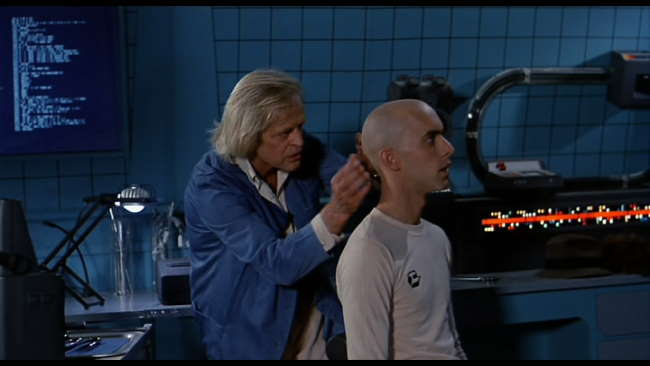
Overview: There are some really good Sci-Fi movies that I don’t consider strictly cyberpunk, but still are strong enough in some ways that I feel compelled to include here. Android is one of those films. Android, in a very low-budget manner, gives us a wonderful exploration of androids and their early attempts to assimilate with humankind. On top of this, the writing is interesting and the acting is very good, especially Klaus Kinski and Don Keith Opper. The budget is low enough that the FX and set designs actually do detract some from the enjoyment of the film, but not enough to stop you from seeing this.
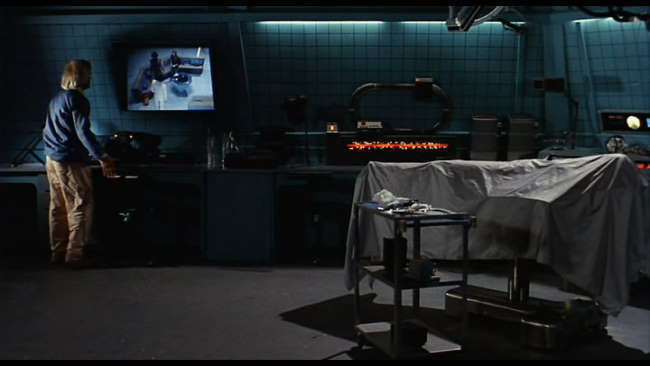
The Story: Android takes place on a large but deserted research-oriented space station located in deep space. Dr. Daniel (played wonderfully by Klaus Kinski), a genius by unstable scientist has almost completed his greatest creation – a perfect female android, named Cassandra. Apparently, Androids have been outlawed on Earth, due to some catastrophic event that occurred previously (hence, the reason for the deep space station), so Dr. Daniel must continue his work under cover with only minimal assistance. His current assistant, Max 404 (Don Keith Opper – also the writer) is also an android, but he is but a prototype – an imperfect experiment may no longer be necessary to continue. Unfortunately, Dr. Daniel needs a living female to “give Cassandra life” by transferring some of her essence to Cassandra.
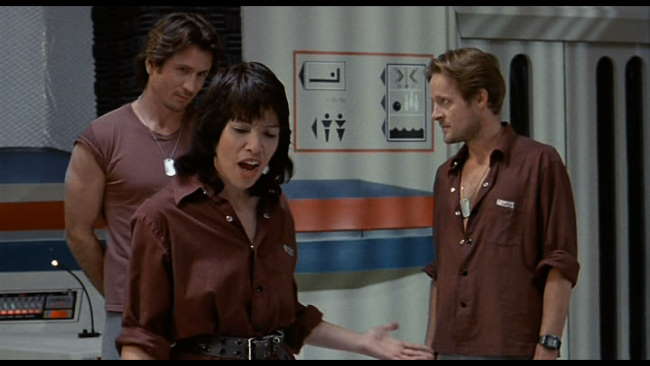
Providence strikes when an outlaw group of criminals on a run-away space ship ends up in their quadrant with a ship in need of repair. As they dock, the criminals, two men and a woman, happily greet Dr. Daniel and Max, and begin looking for what’s valuable to steal, while Dr. Daniels sees this as his golden opportunity to get a woman to finalize his android. Max 404 is immediately attracted to Maggie (Brie Howard), the female convict. At the prompting of the other convicts, Maggie humors Max 404 in order to find out more information. Things come to a head when Max 404 overhears Dr. Daniel say that Max will be deactivated when Cassandra comes online. Max decides his only chance for life is to leave with the convicts, and decides to take things into his own hands.
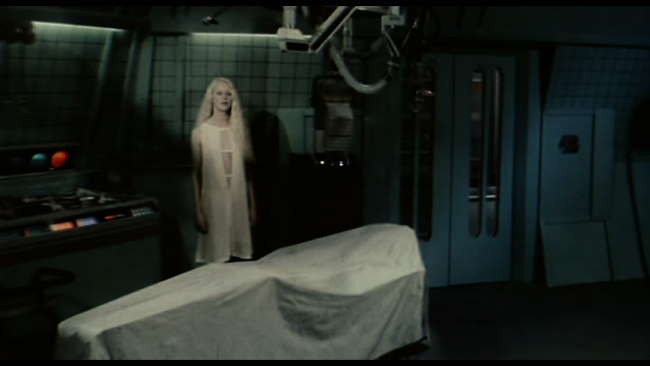
Metropolis’ Maria Recreated: Android employs some fun linkages between previous movies. Max 404 tends to enjoy old B&W, and tends to watch ones that foreshadow coming plot scenes. One of the cool scenes in this movie was when Max 404 is watching the movie Metropolis on the computer monitor. The scene where the evil scientist, C.A. Rotwang is creating an evil android version of Maria from the human Maria. In Android, Dr. Daniel needs to capture Maggie to use her essence to “give life” to the perfect android, Cassandra. The parallels are obvious, and are appreciated to anyone familiar with Metropolis. In another scene, Max 404 is watching “It’s a Wonderful Life” where Stewart finally gets up the urge to go see Mary at her house – this occurs right before Max 404 has his love scene with Maggie.
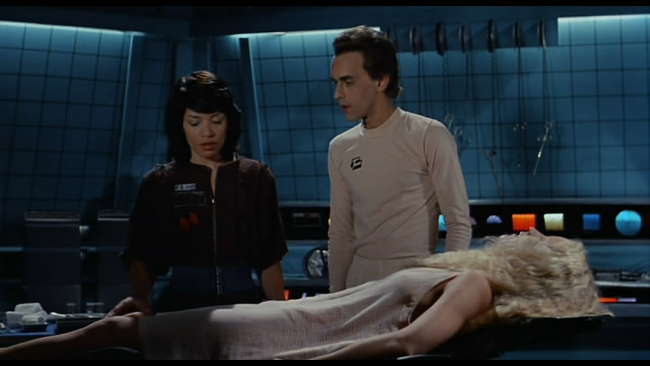
Android Coming of Age Story: One of the really interesting things about Android is Max 404, only 5 years old, engaging in a coming of age type story. Max has the ability to think and feel, but has never experienced anything outside the boundaries of the space station. He spends his time dreaming of Earth, playing video games, and imaging himself engaging in interesting life experiences. He’s not human, but unfortunately for Max, this is the only model he has in determining how to act and react to new situations. Maggie provides him his first opportunity to “engage” in a way that he’s always wished. As soon has things come to a head, Max’s choices are markedly different than a human might be. Max doesn’t feel guilt, nor does he worry about human taboos such as murder, etc. But the highlight of the movie is Don Keith Opper’s acting when he thinks Dr. Daniel (Kinski) is going to deactivate him – this alone is almost worth watching the movie for.
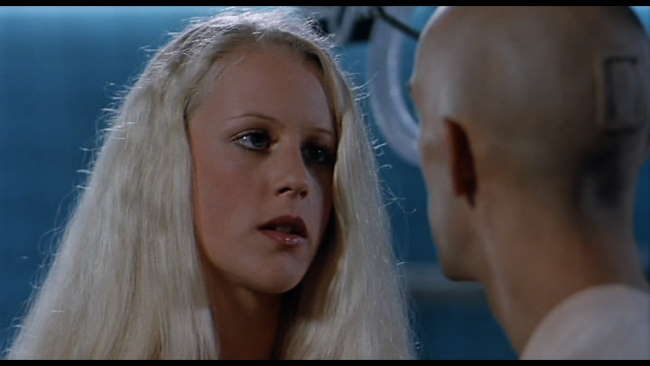
Notice the control panel on the back of Max 404’s head.
The FX: The FX in Android is extremely low-budget. In listening to the commentary, we find out that the story was written as a way to gain additional monetary benefit out of an existing space station set. Android never veers into Dr. Who FX territory, but there are a number of cheesy looking elements that do detract somewhat from the mood. The ships that come to dock have a decidedly Saturday morning kids show look, and the guest suites look very 70s with the off-color strips going around the wall. Still, for the most part things generally work.
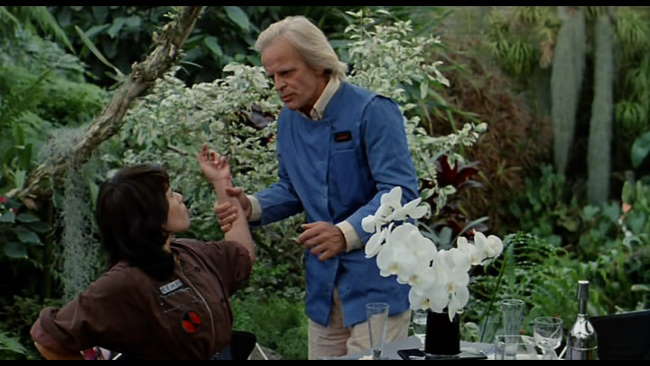
The Bottom Line: Android is one of the really well made low-budget Sci-Fi movies of the 80s. The FX aren’t great, (except for one cool scene that’s a spoiler – DON’T CLICK on this unless you’ve seen the movie - spoiler “decent FX” shot), but the story more than makes up for it. Android gives us a pretty interesting view of a young, imperfect android, engaging in the “coming of age” story, and dealing with challenges far different than perhaps a human might. The ending is also interesting, when Cassandra finally awakes – she too acts differently than expected. In short, Android is a very well written, well acted, and interesting low-budget Android flick.
~See movies similar to this one~
Movie Review By: SFAM
Year: 1987
Directed by: Paul Verhoeven
Written by: Edward Neumeier & Michael Miner
IMDB Reference
Degree of Cyberpunk Visuals: High
Correlation to Cyberpunk Themes: Very High
Key Cast Members:
Officer Alex J. Murphy/RoboCop: Peter Weller
Officer Anne Lewis: Nancy Allen
Dick Jones: Ronny Cox
Bob Morton: Miguel Ferrer
Clarence Boddicker (Crime Lord): Kurtwood Smith

Overview: One of the truly unique movies in the cyberpunk genre, Robocop seems to be slowly receding from our conscious. No longer (in the US) is it carried at places like Best Buy. This is truly a shame because Robocop offers us one of the best instances of near-future cyborgs on film, and in the process, raises some pretty interesting questions. One top of this, Robocop offers some really fun satire along with an in-your-face realistic violence tone throughout that only adds to its mood.
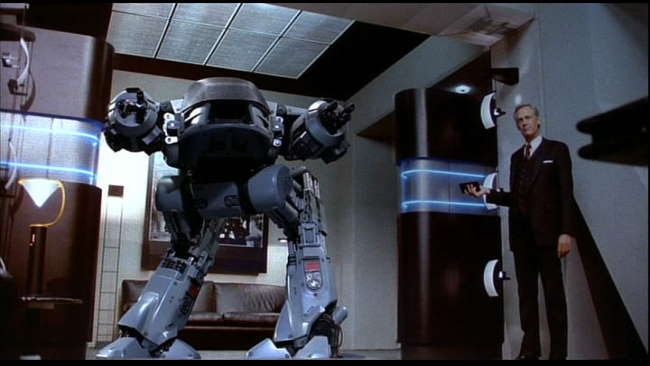
The Story: In a very near-future setting, general law and order has broken down. In the crime-ridden city of Detroit, Omni Consumer Products (OCP) has taken over the public safety duties. To cut costs, they have decided to explore options for automating the police force. One option supported by Dick Jones (Ronny Cox) the number 2 guy at OCP, involves the development of a fully automated mobile weapon system called “ED 209.” While ED 209 is an absolute badass, it screws up in the final demo and ends up peppering one of OCP’s employees in the process.
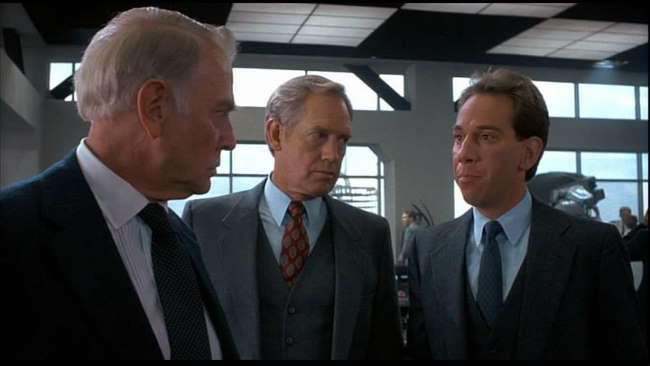
Enter up and coming executive, Bob Morton (Miguel Ferrer). Bob takes ED 209’s demise as an opportunity to convince the CEO to give the Robocop project a try. This involves taking a “just-dead” cop, and embedding the key parts of his body (brain, lungs, heart, etc.) into a robotic body that interfaces and “controls” the mental processes through controlling prime directives. Detective Murphy (played wonderfully by Peter Weller), who has just died in a gruesome death at the hands of Detroit’s crime lord (Kurtwood Smith) becomes the new “volunteer.” His memory is erased, his limbs are removed, and then becomes OCP’s corporate property as their latest innovation.
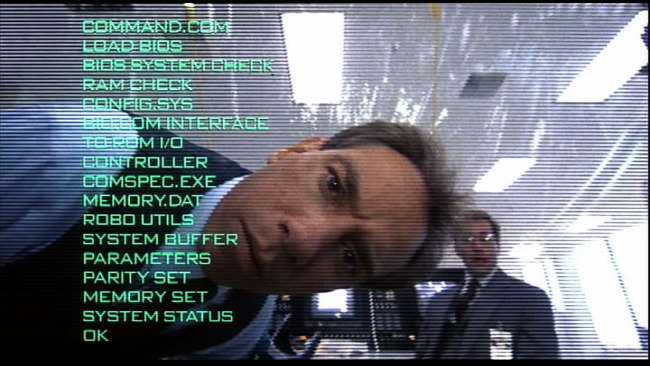
Murphy is transformed into a fully encased crime fighting machine. Robocop is released on the streets to start kicking ass. Unfortunately, Dick Jones doesn’t take his defeat gracefully, and begins to cause trouble both for Robocop’s creator, Bob Morton, and finally for Robocop. It turns out that OCP’s plan for managing detroit’s crime situation isn’t all above board, as there appears to be some linkage between OCP and Detroit’s crime lord. Robocop’s troubles get even worse as he begins to remember who he was in a past life.
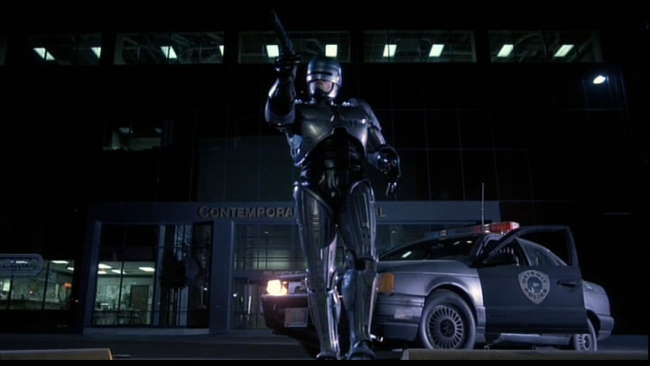
The Satire: Verhoeven is known for having an off-beat sense of satire. In a technique later used for Total Recall and Starship Troopers, Robocop does this primarily through its news reports and commercials. These, along with the corporate greed thematics transforms Robocop into a social commentary on the 80s excesses. The Commoditization of society permeates every aspect of human life in Robocop. Corporations are inherently evil and humanity is a cheap sales pitch. Like Starship Troopers, you’ll continually catch yourself smiling at the commercials and news reports, as Verhoeven really has a talent for this type of satire.
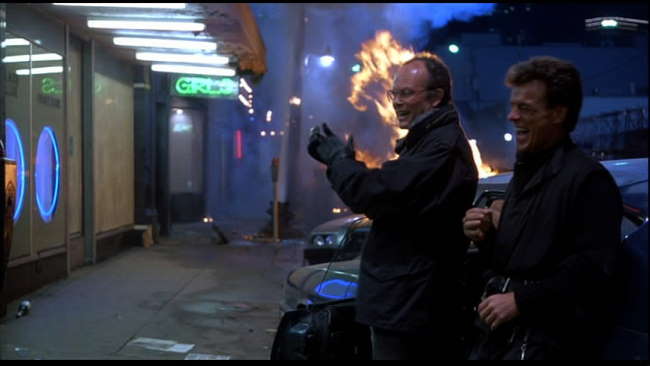
The Violence: Fair warning – Robocop is an extremely violent movie – so much so that upon its initial release, they had to cut two seconds of violence to prevent from receiving an “X” rating. Nothing is held back here, as Verhoeven continually strives for hyper-realism. We see limbs getting blown off, blood spattered faces and walls, and in-your-face gore of all varieties from beginning to end. However, the violence doesn’t stick out as a sore thumb – instead it serves to give the near-future city a nourish realism feel. In short, it works within the context of the narrative and surrounding visuals.
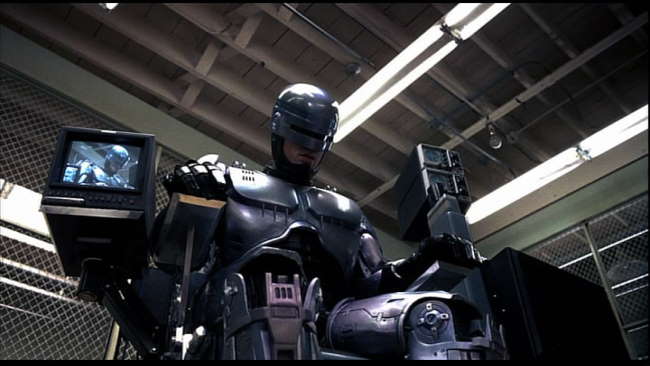
The FX and Set Designs: While Verhoeven gives us a somewhat futuristic city, he seems to err on the side of looking “normal.” We see this most clearly in the Ford Taurus police cars (which were brought in after everyone agreed the futuristic police car designs looked too tacky to be considered). However, the set designs are all wonderfully constructed, and all seem work well with one-another. The ED 209 looks terrific, and the stop-motion animation for it generally works. Robocop’s exterior design does look hoaky at first, but you eventually get used to it. On the other hand, Robocop without his helmet looks flat-out awesome.
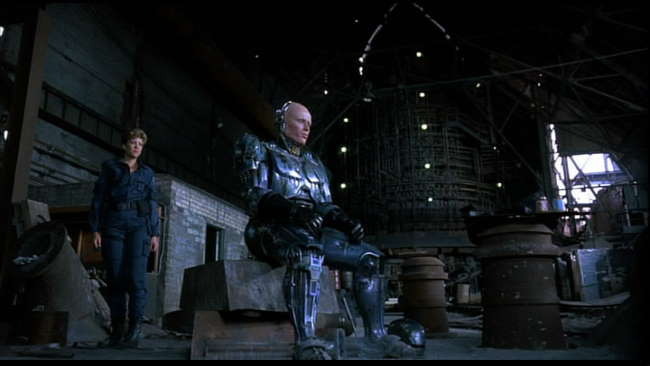
The Cyborg Questions: Robocop/Murphy give us a rich set of questions to ponder relating to cyborgs, the integration of programming with human minds, and in determining ownership after death.
- Cyborg and Humanity: As Murphy begins to realize who he was, and worse, what he’s become, the question asked is what degree of Murphy’s humanity remains? Murphy’s partner, Anne Lewis (played by Nancy Allen) serves to surface these concerns, as she still thinks that Murphy is inside somewhere. Yet, every aspect of humanity has been taken away from Robocop – he doesn’t have a home, but instead returns to a borg-like podchair at night to regenerate. Even if Robocop eventually considers himself human in some sense, it’s no longer clear what that even means. At best, Robocop is part of that strange category we call “post-human.”
- Man-machine interface – Robocop Style: Robocop gives us an interesting look at human brain-matter that has been fully integrated into a cybernetic body. Even more interesting though is the notion that external programming could limit the functioning of the human brain from controlling its new cyborg casing. If we think about it, this isn’t as far fetched as it may initially look: similar to how firewalls block “targeted” information from either entering or exiting a network, Robocop’s programming ensures the human mind adheres to the prime directives. But while the prevention part seems possible, the “directive” nature of the rules seems dubious, as does the erasing of his memory. These perhaps, are far harder to do without destroying the “cop experience” they so desired by picking Murphy in the first place.
- Dixie Flatline Construct Concerns: Similar to the Dixie Flatline Construct in Neuromancer, for all intents and purposes, Murphy is dead prior to being transformed into Robocop. At best we can consider him a zombie as his brain matter was re-animated after death. But like Dixie Flatline, he can think and perform sensemaking. Also like Dixie Flatline, he is limited by programming constraints. However, unlike Dixie Flatline, Robocop can still “feel.” So the question is this – if we develop the capability to re-animate someone’s consciousness after death, do they have the same basic human rights as they did when they were alive? Or are they the property of the corporation who revived them? Even weirder, could corpse’s estate executor (or spouse, for that matter) “sell” the corpse’s consciousness to a third party? If this is so, could your conscious be sold after the fact to pay off unpaid debts? Truly, the questions are mind-boggling!
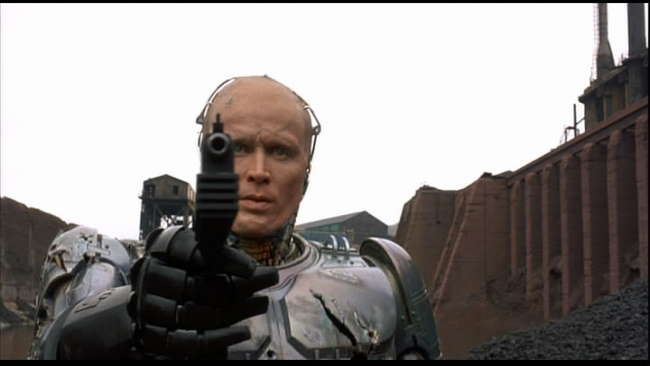
The Bottom Line: Robocop has to be considered one of the essential films of the cyberpunk genre. Some of the action scenes could have been better choreographed (a lot of the bad-guy deaths had the worthless storm trooper feel to them), but truly, the quibbles with this film are minor. Unlike the sequels, which largely come across as pathetic attempts to cash in on the original’s success, Robocop takes itself seriously from beginning to end. Because of this, it really does rise to something special. Even though Best Buy no longer considers Robocop worthy of carrying, don’t let this fool you – assuming you can stand the violence, Robocop deserves to be watched.
~See movies similar to this one~
Year: 1989
Directed by: Albert Pyun
Written by: Kitty Chalmers
IMDB Reference
Degree of Cyberpunk Visuals: Low
Correlation to Cyberpunk Themes: Low
Key Cast Members:
Gibson Rickenbacker: Jean-Claude Van Damme
Nady Simmons: Deborah Richter
Fender Tremolo: Vincent Klyn
Pearl Prophet: Dayle Haddon
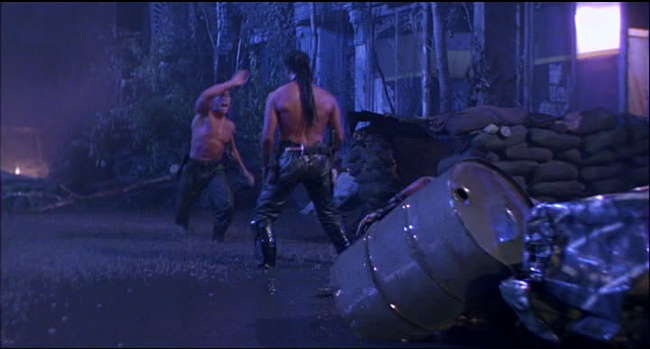
Overview: OK, so you have Jean-Claude Van Damme – a guy that can’t show any emotions other than staring intensely or screaming anger – but at least he’s an awesome fighter. So all you have to do is provide a simple, semi-coherent story that allows the guy to show his two emotions and then spend the rest of the movie kicking ass. Simple, right? Unfortunately, Pyun’s Cyborg fails miserably in the story department. From beginning to end, the rationale for key events are completely non-sensical, which leaves us a steaming pile of crap with pretty good fight scenes.
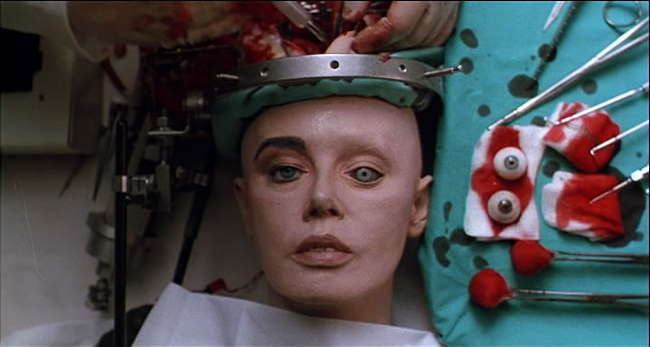
The Story: In a bizarre dystopic future that has ultimate anarchy next to people apparently trying to build little houses on the prairie, a modern version of the plague has devastated an already crippled society. But a cure has been found. And for some reason, these people in one location need to get the cure from another location before it can be used. So…the answer to make this happen is to take one of their hot chick key engineers named Pearl Prophet(played by Dayle Hadden) and TURN HER INTO A CYBORG!!! Why the fuck do they turn her into a cyborg in order to play courier, you ask? Does this make her impervious to attacks? No…in fact, she’s completely worthless as far as combat is concerned. In fact, absolutely NO reason is given for this transformation. We are left to assume that somehow, hard drives only work in the future if they are embedded in people’s bodies (there is a focus on her cybernetic eyes, so perhaps they want us to believe that optical cameras only work in the future if embedded in cyborg eyes). Nor do we find out why the cure will be lost if this cyborg chick dies (gee – if this is a Johnny Mnemonic type thing, can’t they just upload it in chick #2?). In any event, her guardian is killed by the “flesh pirates” and now she needs another body guard. It just turns out that Jean-Claude Van Damme, hero extraordinaire’s one happy family moment was crushed by the flesh pirates, so he’s more than happy to go to the rescue. And for some reason, he’s taken a straggler, Deborah Richter, for the ride.
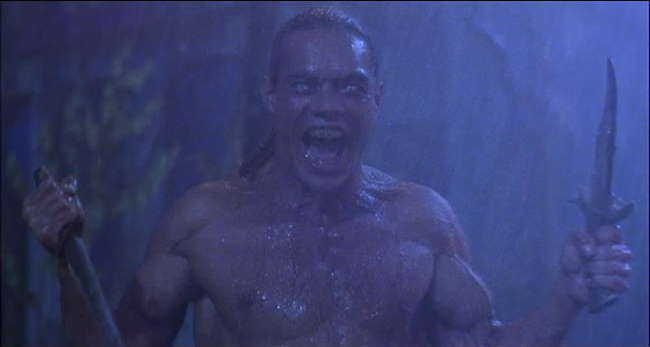
The rest of the movie is a tracking/confrontation movie where Van Damme tracks down Vincent Klyn, leader of the flesh pirates and engages them in fight after fight. Not surprisingly, Van Damme initially gets his ass beat a few times before we get to the predictable ending. In keeping with the whole incoherence theme, in one scene Van Damme is crucified on a ship’s mast (with nails through the hands – the whole bit), but is fully healed by the next evening’s final showdown. Even worse, we find out from Pearl Prophet, the cyborg chick, that her homies back at the fort can kill the pirates anyways, so we are left wondering why Van Damme even bothers.
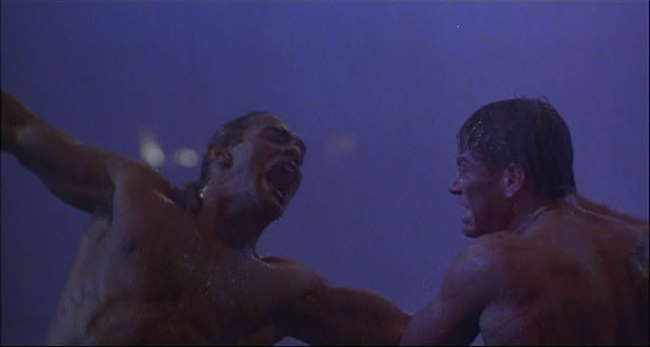
The Bottom Line: The whole goal of the movie was to get Van Damme going at it with buff surfer Vincent Klyn. Why they even bothered to add a cyborg to this is beyond me, as it simply doesn’t fit with the story. Who knows, maybe this was the only thing they had available in their limited FX bag. Well, cool, why not spend the 20 minutes it takes to actually write a rationale for the cyborg’s inclusion? In short, this film was never going to be great, but with a little amount of coherence, it could have been decent. I do give one star extra for the fight scenes, which gives Cyborg 4 stars.
~See movies similar to this one~
Year: 1984
Directed by: James Cameron
Written by: James Cameron, Gale Anne Hurd
IMDB Reference
Degree of Cyberpunk Visuals: High
Correlation to Cyberpunk Themes: Very High
Key Cast Members:
The Terminator: Arnold Schwarzenegger
Kyle Reese: Michael Biehn
Sarah Connor: Linda Hamilton
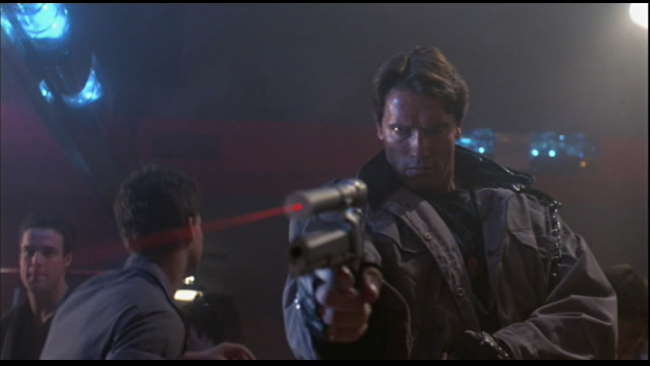
“The Terminator’s an infliltration unit…part man - part machine. Underneath it’s a hyper-alloy combat chassey…microprocessor controled…fully armored - Very tough. But outside its living human tissue…flesh…skin…hair…blood - grown for the cyborgs.”
Overview: No movie has been more imitated in cyberpunk than the Terminator. While most of the imitations have been grade “B” shlock films, they attest to the intense effect that the Terminator had on our consciousness. This film is legendary, and easily ranks in the top 5 or 6 most influential cyberpunk films ever created (Blade Runner, Metropolis, Ghost in the Shell, and The Matrix being the other four, and Alien if you consider that cyberpunk). Terminator is a film with terrific replay value – so much so that I’m guessing all of you have seen it enough times that I don’t need to bore you with a plot overview. With a 6.4 million dollar production budget, this is far from a big-budget blockbuster. The reason it’s stood the test of time, and in fact comes across as a block buster, comes down to incredible execution by beginning film maker James Cameron and cast.
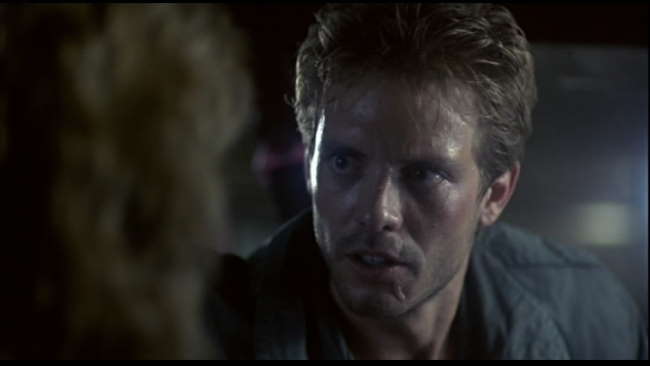
“I’m here to help you…I’m Reece - Sargeant Tech Com BN38416 - assigned to protect you…You’ve been targeted for termination.”
The Acting: From Schwarzenegger’s eery style of acting, to Linda Hamilton’s growth on screen from a shy teen to tough mother of mankind, to Michael Biehn’s tour-de-force performance from beginning to end, the leads flat out carry this movie. That said, the background characters are all terrific, including Bill Paxton at the beginning (“Fuck you, asshole!”), to Paul Winfield (Lieutenant Traxlet), Lance Henriksen (Detective Vukovich) and psychologist, Earl Boen. There are too many memorable scenes to relate here, but the real strength of the acting in this case comes more in expressions and setting mood than it does in delivering the lines, although Beihn’s narrative in particular is riviting.
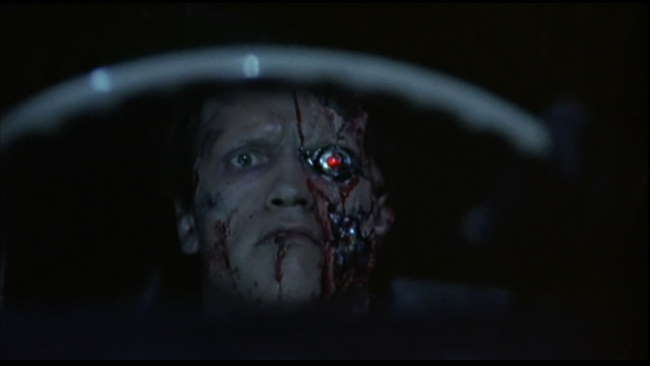
The 600 series had rubber skin. We spotted them easy. But these are new…they look human. Sweat…bad breath…everything…very hard to spot.
Reece’s character does straight exposition to explain the story, which is usually a lousy delivery method. However, the mix of action and exposition just works. The dialogue was terrific, and Reece delivered it in the context of a high-tension chase. During this, Hamilton’s character literally transforms from a vulnerable, girl-next-door to a hard-edged, do-what’s-necessary, take charge kind of gritty leader. Their chemistry is terrific. They have a shy tension, that eventually turns into an intense, believable love affair. It’s kind of amazing that the studio originally wanted Arnold Schwarzenegger to play Reece. Schwarzenegger as the Terminator provides us one of the all time characters in all of scifi. He is the ultimate warrior android, and has been imitated far too many times to count.
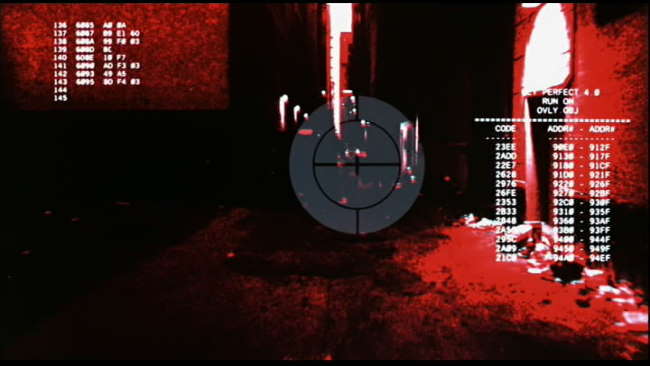
“There was a nuclear war…about a few years from now…all this….this whole place…its gone…just gone… the survivors…here…there…nobody knew how it started…it was the machines, Sarah.”
The Pacing: The Terminator’s pacing is probably the most copied aspect of this film. The Terminator, from the very first scene to the very last is a chase movie. The tension goes from high to massively high to short breathers, back to massively high tension. You literally feel tired after watching this. While this doesn’t seem unusual now, back in the early 80s, The Terminator took the hectic fast pacing of Raiders of the Lost Ark and adapted it to a full scale chase flick. The real magic here was Cameron’s ability to embed a fascinating story into the chase, while changing the bad guy from human to robot to basically add a completely new feeling to the chase.
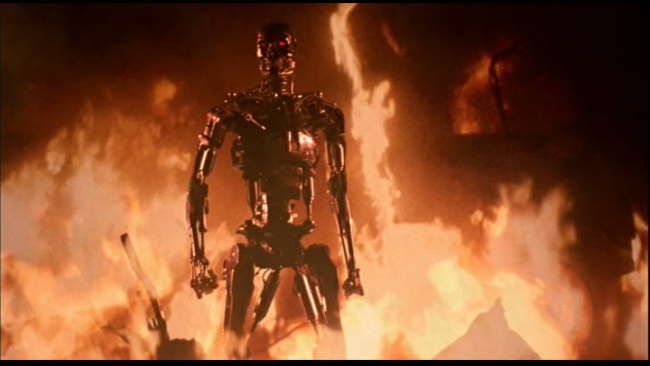
“You still don’t get it, do you…He’ll find her. That’s what he does! That’s ALL he does! You can’t stop him. He’s wade through you, reach down her throat and pull her fucking heart out!”
The FX: For the budget, Terminator’s FX far exceeded anything that should have been possible. The Endoskeleton, made up of miniatures, models and stop-motion animation, is now part of movie lore. The car chase scenes still look terrific, as do the explosions. The near-future dystopic scenes are completely riveting, especially the flying HKs! However, a few of the model shots of Arnold do look slightly dated now (most noticeably when Arnold takes out his eye).

“In the few hours we had together, we loved a lifetime’s worth.”
The Score: Brad Fiedel’s percussive, driving beat that creates an industrial masterpiece that absolutely nails the feeling of The Terminator. You can still here the “dun-dun dun dun-dun” beat and IMMEDIATELY get teleported back to that sense ominous doom of the future that the Terminator portends.
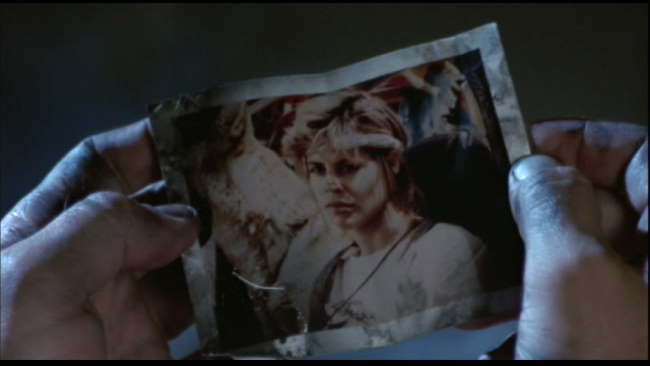
“That was a good hussle, kid.”
Time Travel: The Terminator provides us one of the best time travel movies in cinema. It’s intelligently done in a coherent way that really sets the picture moving. But the real majesty is in the photograph (see above). I LOVE the picture and everything it represents. There, in that one image, we get the entire love affair of Sarah and Reece, John’s struggle relating to someone he knows to be his father (but who cannot know in return), Sarah’s future journey, and a wonderful mind fuck to boot! The placement of the time travel elements at the beginning and ending of the story really do add impact to its meaning.
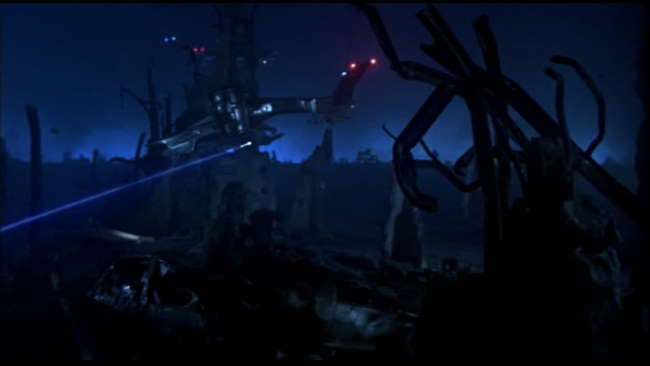
“You stay down by day, but at night you can move around. You still have to be careful because the HK’s use infrared…they’re not to bright…John taught us ways to dust them…”
Guerilla Filmaking: In watching the most awesome extras on special edition DVD, it’s clear that the Terminator was way over-ambitious (thank God!). In post-production, it was clear to Cameron that a number of additional unfunded scenes were needed in order to make a complete picture. Cameron used his weekly director’s pay to pay skeleton crews to go out and do additional shots – often which used incredibly low-end effects. For instance, the body bag used at the end was actually Cameron’s suit bag. The scene at the beginning where Arnold breaks into the station wagon was filmed with just him and Cameron, worrying about the police seeing them as Arnold breaks the car window (Arnold’s clothes for the scene were in his trunk – he had to change in the car!). More incredibly, the last shot of the Terminator, where the red eye slowly fades, was shot later – the smoke you see there was someone breathing cigarette smoke on the eye! In short, everyone gave blood, sweat and tears to make sure this film looked as good as it did.
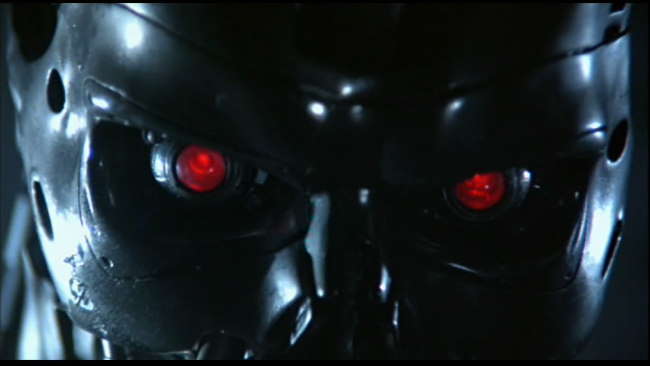
“That terminator is out there…it can’t be bargained with…it can’t be reasoned with. It doesn’t feel pity, or remorse…or fear. And it absolutely will not stop - EVER - until you are dead!”
The Bottom Line: The mood, energy and intensity of The Terminator oozes from every pore of the first shot to the last. If you are one of the very few who has not experienced this movie, you’re in for a treat! If you’ve seen it before (many times even), chances are you’ll be seeing it again. The Terminator definitely deserves a place of honor in the pantheon of cyberpunk flicks. One problem this film does give from a categorization perspective - they call the Terminator a cyborg, but he is really an android (even Cameron calls him this on the extras). The definition of a cyborg implies an augmented human, not an android covered with human tissue. I give it 9 stars as a movie, but add an additional star for its overall impact on film making.
Terminator Page 2: More Screencaps–>>
~See movies similar to this one~
Year: 1988
Directed by: Kazuhito Kuramoto
Written by: Kazuhito Kuramoto
IMDB Reference
Degree of Cyberpunk Visuals: Medium
Correlation to Cyberpunk Themes: Medium
Key Cast Members:
Dwarf Scientist: Toshihiko Hino
Scientist’s dying sister: Mio Takaki
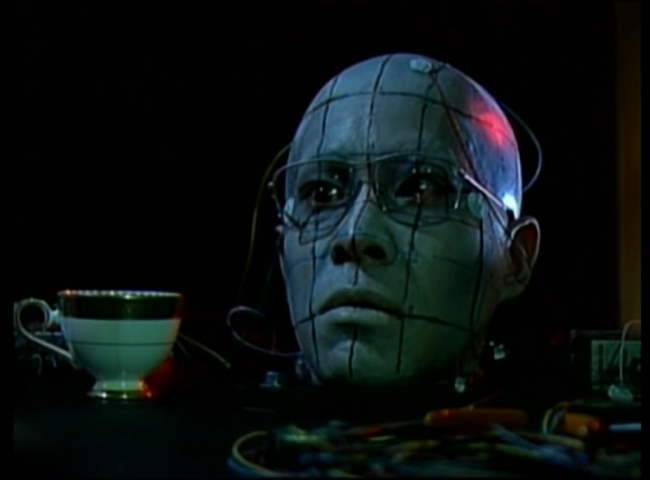
Overview: Japanese Cyberpunk films are always looking to extend the boundaries of humanity, but hopefully they do so within the constraints of a semi-coherent plot, with actions by the characters that make sense within the twisted view of the narrative. Android of Notre Dame does away with most of that, and instead goes for massive gross-out scenes with characters whose actions rarely make sense. Gooey substances of all colors and textures come spewing out of every crevice possible from this head in the above shot.
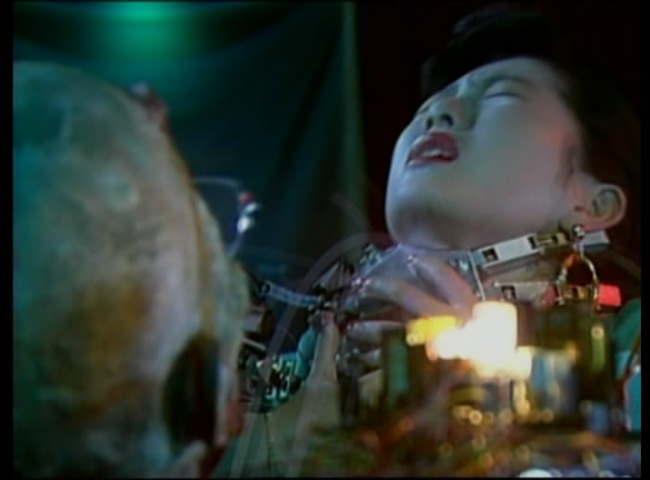
This story, such as it is, has a Japanese dwarf scientist playing a modern-day Dr. Frankenstein (well, Dr. Frankenstein as the hunchback of Notre Dame, actually) in an attempt to find a way to prolong his dying sister’s life. Yet, instead of going to the morgue, he goes out and finds associates, kills them in gruesome ways and then performs experiments on their various body parts. His most successful one is shown in the picture at the top, where he takes a guy’s head and hooks him up to a variety of wires and implants that allow the “android” (or really, we would call this a cyborg) to have facial movements, control a robotic arm and also can record his visual perceptions into a television. He also has his cyborg head kill this other chick so he can remove her heart in an attempt to fix his dying sister’s heart.
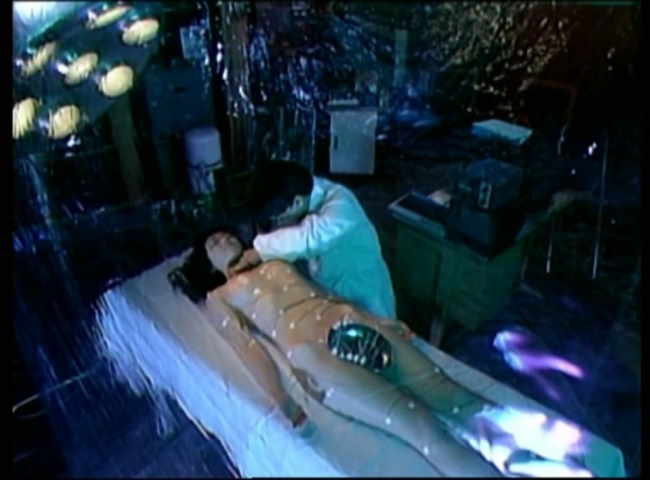
Image modified to obfuscate nudity. Go here if interested in seeing the unmodified image.
The Bottom Line: The idea behind Android of Notre Dame is rich, and, had it been executed better, might have yielded a pretty good Japanese Cyberpunk Flick. The ending scene in particular, where we see the scientist’s final failed solution is especially intriguing. Unfortunately, it seems that the Kuramoto was more interested in capturing gross-out scenes than he was in pursuing a promising, if limited story line.
~See movies similar to this one~
Year: 1987
Directed by: Shirow Masamune
Written by: Shirow Masamune
IMDB Reference
Degree of Cyberpunk Visuals: Medium
Correlation to Cyberpunk Themes: Medium
Key Cast Members:
Sybel: Yoshiko Sakakibara
Ferris: Chisa Yokoyama
Dr. Matthew: Ichirô Nagai
Col. Arthur: Shinji Ogawa

Overview: Masume Shirow’s Black Magic M-66 is one of the best Terminator anime clones. Most know Masume Shirow from his Appleseed and Ghost in the Shell Mangas, not to mention his myriad of other hot chicks kicking butt artwork (Intron Depot Ballistics is my favorite). Black Magic M-66 is his first anime. The visuals, while quality, are definitely 80s cartoon style.

In this “When Good Fembots Go Bad” tale, a tough and sexy journalist who likes to hang out in the buff picks up a military transmission on her scanner about an escaped weapon system. In her haste to get the story, she almost forgets to put on clothes, but finally comes back for a pair of pants. She eventually tracks the military to the woods and finds them besieged by an android weapon accidentally “turned on” after a horrible cargo plane crash.
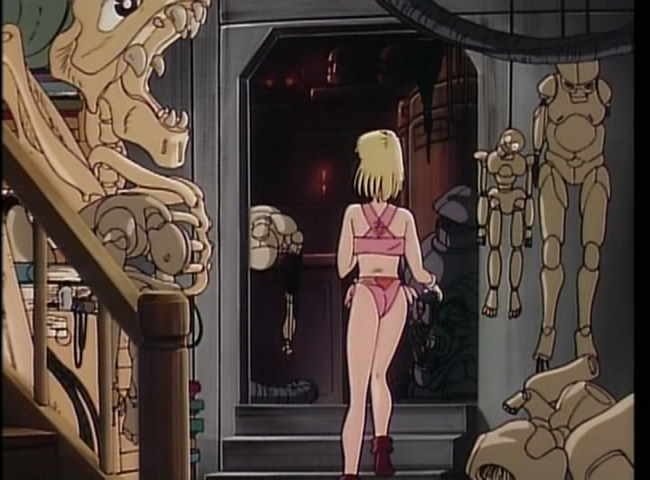
This android chick is ultra-tough, nearly unstoppable, and, due to it running on laboratory test data, apparently has been programmed to kill the inventor’s daughter. The reporter figures this out tries to rescue the android inventor’s daughter, but the M-66 is hot on her heels. All hell breaks lose in this anime, which is essentially a Terminator-style chase from beginning to end.

If you’re a cyber-studies researcher in need of a good example of cyberpunk’s propensity for objectification of women, Black Magic M-66 is your movie! You get a bevy of good stereotypes here, including the tougher than tough, smarter than smart, ultra-hot reporter who doesn’t like to wear clothes, the needy and continually fainting daughter always in need of rescue, and of course the M-66 weapon system - made in a woman’s image for God knows what reason (other than the obvious, of course). Again, this movie doesn’t bother you with needless philosophies that might confuse things - its all visual.

The Bottom Line: Black Magic M-66 does not have in-depth philosophical questions - its not that type of cyberpunk anime. This is an action-fest from the get-go. It doesn’t bother giving you lots of in-depth set-up or character rationales. The action is good though, and the pacing is consistently fast and tense, and generally goes fast enough for you to ignore plot holes and bizarre side questions like why was the inventor’s daughter in the target the “test” data. The anime is still 80s style, especially in the backgrounds, but Shirow always does fine quality products.
~See movies similar to this one~
Tags: cyberpunk movie review anime M-66
Year: 1982
Directed by: Slava Tsukerman
Written by: Anne Carlisle, Nina V. Kerova & Slava Tsukerman
IMDB Reference
Degree of Cyberpunk Visuals: Medium
Correlation to Cyberpunk Themes: Very Low
Key Cast Members:
Margaret/Jimmy: Anne Carlisle
Johann Hoffman the Scientist: Otto von Wernherr
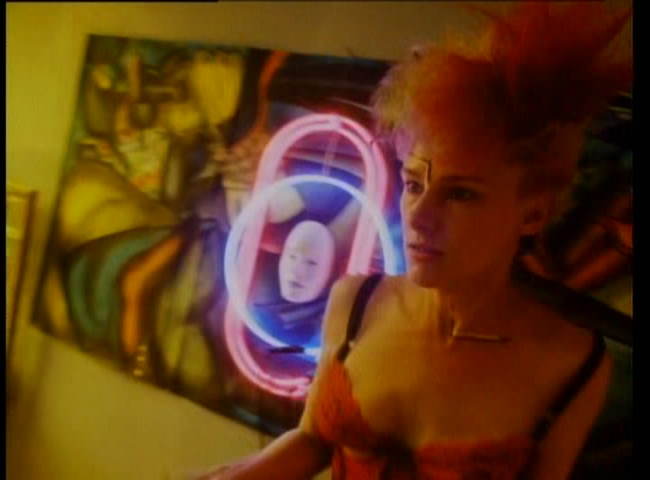
Overview: Liquid Sky is another movie that makes a number of cyberpunk lists. Personally, I don’t think so. It has absolutely NO cyber aspects (it does have scifi aspects though). However, it’s so strong on the punk side that from a visual standpoint I suppose a case can be made for inclusion. This is a very low-budget art film that is emphasizes “weird” from the get go. If I were to rename it, I would call this “The movie where the Punks say Fuck!” as they do so every other word. The real effort here is NOT in the acting (most is horrible, but Carlisle is decent), or the story, or the pacing. The goal is to create a weird punk immersion that gives the film an other-worldly quality. This is emphasized by the completely non-sensical alien pie-plate spaceship.
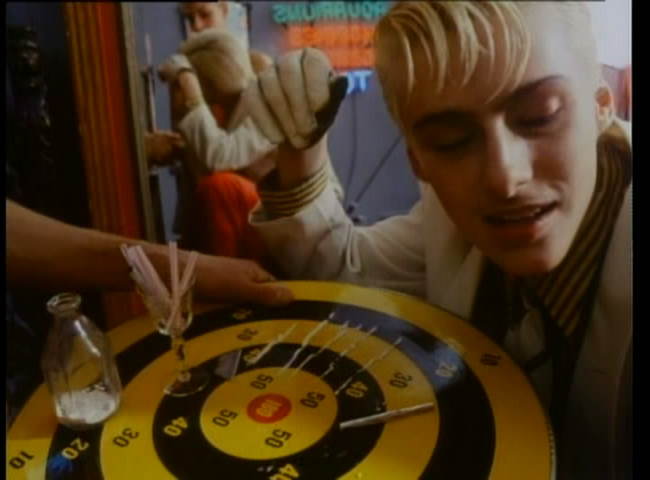
Liquid Sky takes place in modern times (early 1980s) where a very small alien space ship is looking for a heroin fix and settles on top of a punk-apartment building where drug addicts are the order of the moment. The space ship “steals” the emotional state of the heroin addicts to give itself energy. We soon find out that the aliens can also get their fix from people having orgasms. In line with this, the aliens follow around Margaret (played by Liquid Sky writer, Anne Carlisle, who also plays the role of the androgynous Jimmy in the picture above), who is continually getting raped and forced into having sex with people she doesn’t like. She never orgasms, but her partners always do. At first, the aliens appear to steal this energy by impaling the victims with a crystal scepter, but later, the victims just disappear. Anne starts to think her vagina has the power to kill, and either tries to stop having sex with people she likes (which fails) or seeks out those she hates in order to kill them. All the while, a European scientist, who’s big on the narration (this is the only way we learn what’s going on) is tracking down the alien ship and is attempting to warn the punks.
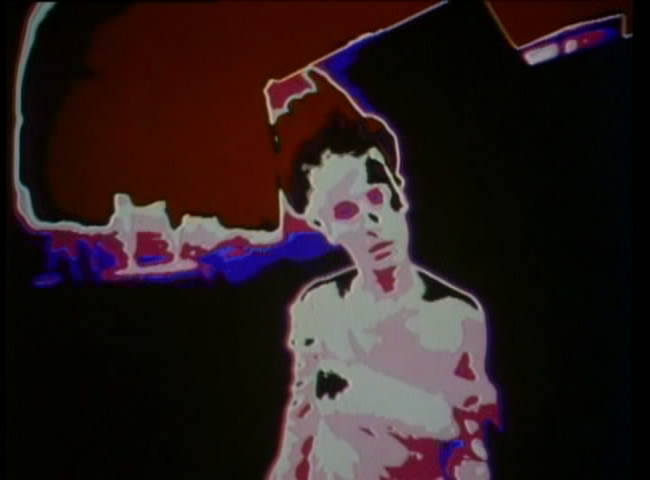
Overview: This movie is a massive cheesefest in every sense of the word. It is quirky enough to be interesting though (hence the 5 stars instead of 4), and is certainly original to the point that I could certainly imagine some enjoying this multiple times. Again, for the moment I’ve decided to include it as a cyberpunk flick, but I’m sorely tempted to move it to the “not cyberpunk” category. Even though the visuals qualify in a strange way, there is no cyberpunk themes to speak of here.
~See movies similar to this one~
Tags: cyberpunk movie review LiquidSky
Year: 1983
Directed by: David Cronenberg
Written by: David Cronenberg
IMDB Reference
Degree of Cyberpunk Visuals: Medium
Correlation to Cyberpunk Themes: High
Key Cast Members:
Max Renn: James Woods
Nicki Brand: Deborah Harry
Bianca O’Blivion: Sonja Smits
Harlan: Peter Dvorsky
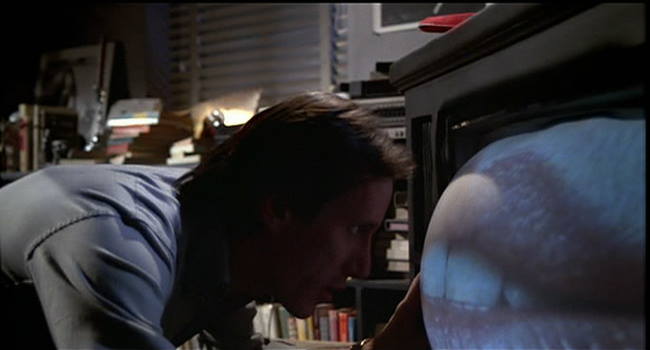
Overview: Videodrome, another interesting flick from mind-fuck horror master, David Cronenberg, provides us an interesting commentary on the effects of total immersion into a mass-media culture. Filmed for a paltry 6 million, this movie generated significant buzz upon release as one of the weirder movies ever made. Unfortunately, its FX don’t age well, and maybe I’ve seen just a few too many weird movies to consider Videodrome all that strange now. But if you’re in the mood for a strange cyberpunk horror, this is one to consider.
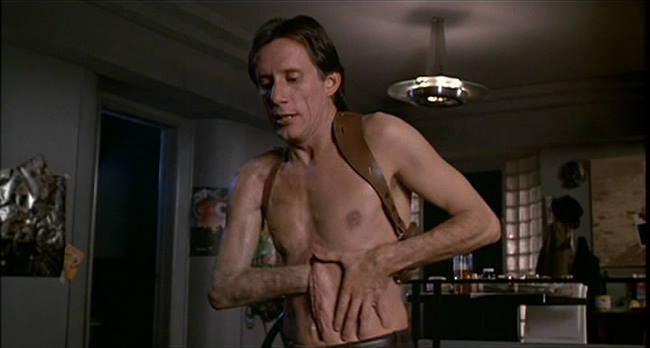
The Story: Max Renn (played wonderfully by James Woods), a sleazy two-bit cable TV executive is always on the lookout for shows that pass the bounds of human decency. One day while scanning the satellite feed, his engineer stumbles upon an S&M, broadcast from a strange production company called Videodrome. Not only are the subjects beaten, they may even be involved in creating a snuff film. Curiosity gets the better of Max, and he becomes obsessed with finding the broadcast.
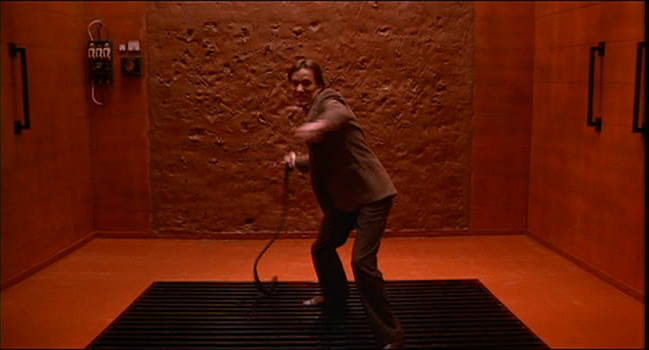
Along with his pain and pleasure girlfriend (played by Blondie’s Deborah Harry), Max finds the broadcast, and is then shocked to learn that his girlfriend has left to become a star on Videodrome. In pursuing her, and in wanting to experience Videodrome for himself, Max becomes captivated by the Videodrome signal. The wall between reality and fantasy dissolves and Max becomes a pawn in a plot to broadcast Videodrome’s subliminally controlling signal to millions.
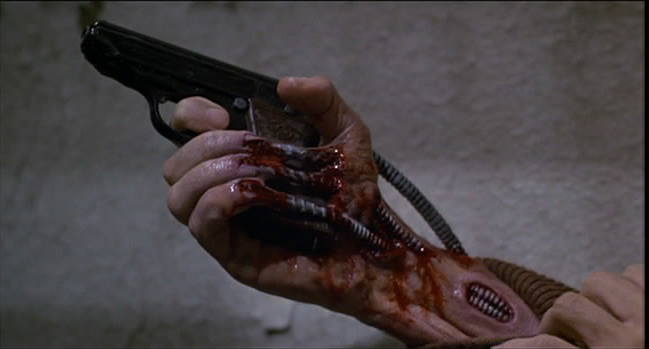
Cyberpunk Musings: If we strip out the bizarre and magical horror stuff, Videodrome’s message is that total immersion into mass media dehumanizes us. It excites us into a state of hyper-violence and deviant sexual desires. Videodrome’s desire to create the “new flesh,” in movie terms is the merging of human consciousness with mass media. In a more post-human sense, Cronenberg seems to be saying that humanity itself is becoming lost as society slips further and further into this new mass-media culture. By feeding our deviant unconscious desires that have been surfaced by addiction to mass media, in effect, our humanity and individualism is lost.
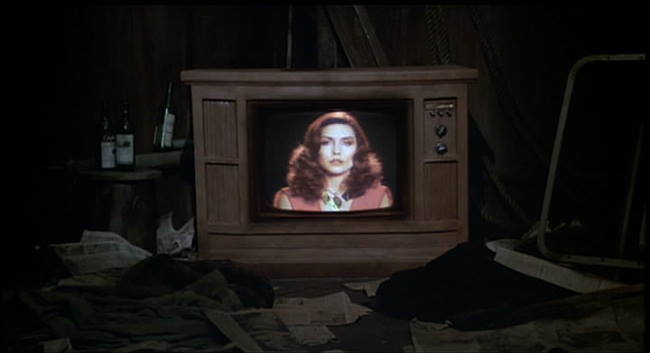
The Bottom Line: Even though the effects seem dated, Videodrome is still a pretty weird head trip. The characters are by no means deep, but the acting is good enough to keep you entertained in places where the story falters. I will say the as a whole, the cinematography wasn’t the greatest – there were significant lighting issues, and very little imagination in camera angle placements. But whether you watch this movie purely for the horror or the philosophy, the ideas are interesting enough to keep you entertained even with the FX start to falter. I’m torn between giving this film a 7 star rating or an 8 star rating – for now I’ll give it 7 stars until someone provides a good enough argument to merit changing it.
~See movies similar to this one~
Tags: cyberpunk movie review Videodrome
Year: 1983
Directed by: John Badham
Written by: Lawrence Lasker & Walter F. Parkes
IMDB Reference
Degree of Cyberpunk Visuals: Very Low
Correlation to Cyberpunk Themes: Medium
Key Cast Members:
David Lightman: Matthew Broderick
Jennifer Katherine Mack: Ally Sheedy
Dr. John McKittrick: Dabney Coleman
Dr. Stephen Falken: John Wood

Overview: War Games is a wonderful 80s film that captures both the cold war fears and the budding hacker mentality. Mathew Broderick plays a geek teenager named David, who has fun hacking into open modems to noodle around with unidentified computer systems. He finds one computer that likes to play chess. Eventually, he finds this computer also likes to play Global-thermonuclear war. Unfortunately, while playing, he unknowingly starts the Strategic Air Command computer’s countdown to thermo-nuclear war.

This movie is lots funnier when we consider the DoD IT fuckups from the late 70s in building computer-based command and control systems such as this. Twice, in the middle of the night, President Carter got racked out of bed to be told that the Soviets had launched - only a minute later to be told, “Sorry, it was just test data” that was being run on their new $100 Million dollar computer system. After the second such instance, President Carter made it known that he no longer found this amusing. Unfortunately, the designers of this system in their infinite wisdom had the specifications written so that test simulations had to be performed on the live system. For obvious reasons, this is about as bad an idea as has been considered, let alone implemented. They ended up having to spend an additional 50 million to build a test system, that was thereafter known as “Bozo the Clone.”

The Bottom Line: It is definitely a stretch to call War Games cyberpunk. The only thing that makes it so is the pre-Terminator plotline concerning the Military’s attempt to allow machines to manage key decisions for society and the hacker subplot. While not as dystopic as Colossus - the Forbin Project (still awaiting review), the theme is executed competently, especially when combined with what was then the advent of the hacker movement. This is well acted, and for the most part, a decent “pre-cyberpunk” style movie.
~See movies similar to this one~
Tags: cyberpunk movie review Wargames
Year: 1989
Directed by: Steven Lisberger
Written by: Tony Kayden (screenplay), Bill Bauer (story)
IMDB Reference
Degree of Cyberpunk Visuals: Very Low
Correlation to Cyberpunk Themes: Low
Key Cast Members:
Matt Owens: Bill Paxton
Byron: Bob Peck
Belitski: Kitty Aldridge
Will Tasker: Mark Hamill
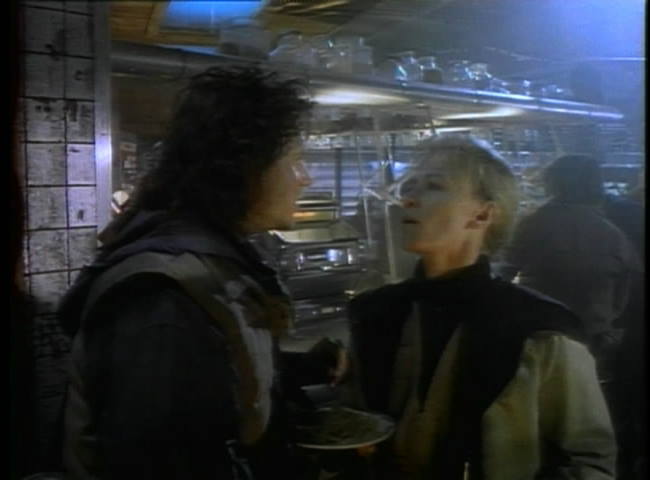
Overview: Slipstream is a movie directed by Tron’s Steven Lisberger, who, thankfully, time has mostly forgotten. This movie is supposed to take place in some future time where the continents have all reshuffled themselves due to Earthquakes (yes, you might think this would take hundreds of millions of years, but Lisberger apparently knows better). For the most part, Slipstream is a pretty lousy movie. Especially lousy are the costumes and set designs. The costumes consists of regular 1980s attire, while the set designs, what little there are seem hastily manufactured with little attention to detail.
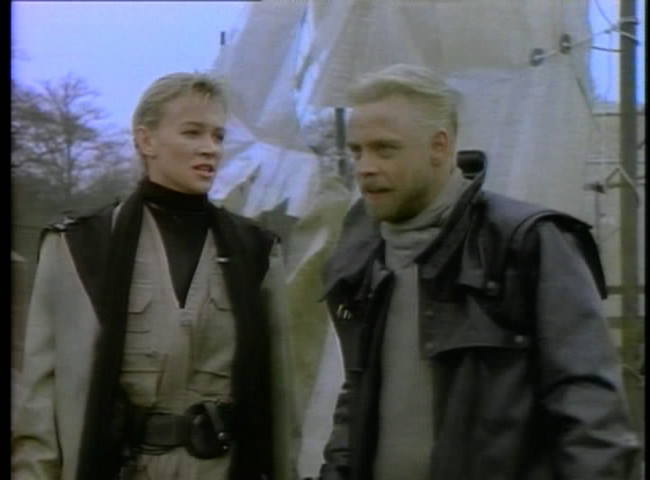
The plot concerns an escaped android named Byron, who’s apparently killed someone, and has escaped to the fringes of society. The police bounty hunters, played by Mark Hamill and Kitty Aldridge, have just caught him after a 3 month trek, and are on their way back to bringing him in. On a stopover to get some food, they run into Matt, played by Bill Paxton, who sees Byron as his ticket to money and happiness. Without knowing he’s an android, Matt steals Byron from the police, and escapes down the “slipstream,” A river running down a huge gorge that seems to generate its own wind power. The rest of the movie is about Byron’s emergence and his friendship with Matt, while still evading the bounty hunters.

Android Freewill: The only interesting part of this movie concerns a scene where Byron has just been told he’s free, and, experiencing true freewill for the first time, is completely overloaded. He doesn’t know how to handle it and immediately asks for Matt to tell him what to do. This scene is a little too “in your face” but it is the highlight of the movie, and really, pretty much the ONLY aspect of this movie that feels cyberpunk.
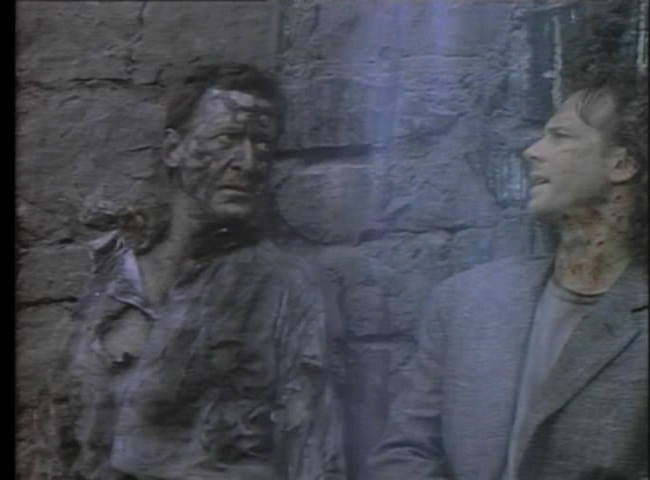
The Bottom Line: There really isn’t much here. If you haven’t seen it, you probably won’t feel too bad. I will say that for the most part, the four acting leads give decent performances - this more than anything allows me to give it 5 stars. It’s a shame they had so little to work with. The plot is forced, the sets are aweful and the costumes are basically what the actors wore to the shoot.
~See movies similar to this one~
Tags: cyberpunk movie review Slipstream
|
























































